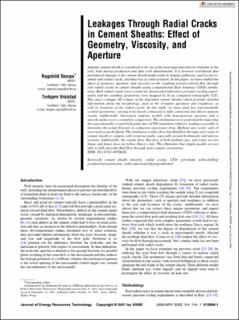| dc.contributor.author | Skorpa, Ragnhild | |
| dc.contributor.author | Vrålstad, Torbjørn | |
| dc.date.accessioned | 2022-06-17T10:07:45Z | |
| dc.date.available | 2022-06-17T10:07:45Z | |
| dc.date.created | 2021-12-02T21:33:58Z | |
| dc.date.issued | 2022 | |
| dc.identifier.citation | Journal of energy resources technology. 2022, 144 (1), 013006-?. | en_US |
| dc.identifier.issn | 0195-0738 | |
| dc.identifier.uri | https://hdl.handle.net/11250/2999271 | |
| dc.description.abstract | Annular cement sheath is considered to be one of the most important barrier elements in the well, both during production and after well abandonment. It is however well-known that mechanical damage to the cement sheath might result in leakage pathways, such as microannuli and radial cracks, and thus loss of zonal isolation. In this paper, we have studied the effect of geometry, aperture, and viscosity on the resulting pressure-driven flow through real radial cracks in cement sheaths using computational fluid dynamics (CFD) simulations. Real radial cracks were created by downscaled laboratory pressure cycling experiments and the resulting geometries were mapped by X-ray computed tomography (CT). This gave a unique 3D volume of the degraded cement sheaths which provides detailed information about the morphology, such as the irregular apertures and roughness, as well as locations of the radial cracks. In this study, we have used five experimentally created geometries, varying from barely connected to fully connected and almost uniform cracks. Additionally, theoretical uniform models with homogeneous aperture and a smooth surface were created for comparison. The simulations were performed by importing the experimentally created leak paths into a CFD simulation software, making it possible to determine the actual flowrate as a function of pressure drop. Methane gas, water, and oil were used as model fluids. The simulation results show that fluid flow through real cracks in cement sheath is complex with torturous paths, especially around bottlenecks and narrow sections. Additionally, the results show that flow of both methane gas- and water are not linear and hence does not follow Darcy's law. This illustrates that simple models are not able to fully describe fluid flow through such complex geometries. | en_US |
| dc.language.iso | eng | en_US |
| dc.publisher | ASME | en_US |
| dc.subject | wells-injection/oil/gas/geothermal | en_US |
| dc.subject | petroleum wells-drilling/production/construction, | en_US |
| dc.subject | CFD | en_US |
| dc.subject | radial cracks | en_US |
| dc.subject | cement sheath integrity | en_US |
| dc.title | Leakages Through Radial Cracks in Cement Sheaths: Effect of Geometry, Viscosity, and Aperture | en_US |
| dc.title.alternative | Leakages Through Radial Cracks in Cement Sheaths: Effect of Geometry, Viscosity, and Aperture | en_US |
| dc.type | Peer reviewed | en_US |
| dc.type | Journal article | en_US |
| dc.description.version | publishedVersion | en_US |
| dc.rights.holder | Copyright © 2021 by ASME | en_US |
| dc.source.pagenumber | 10 | en_US |
| dc.source.volume | 144 | en_US |
| dc.source.journal | Journal of energy resources technology | en_US |
| dc.source.issue | 1 | en_US |
| dc.identifier.doi | 10.1115/1.4052610 | |
| dc.identifier.cristin | 1963860 | |
| dc.relation.project | Norges forskningsråd: 309646 | en_US |
| dc.source.articlenumber | 013006 | en_US |
| cristin.ispublished | true | |
| cristin.fulltext | original | |
| cristin.qualitycode | 1 | |
